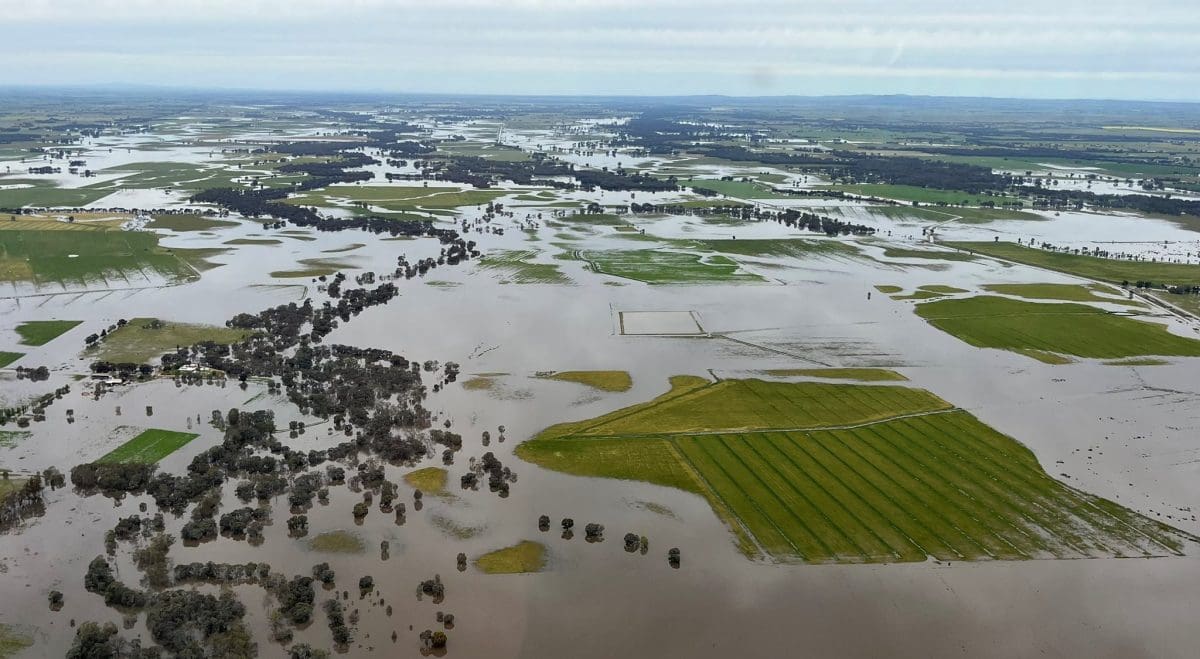
Floods have inundated paddocks and cut roads across much of central and northern Victoria including the Boort district. Photo: Tyler Nelson
FEEDGRAIN prices are rallying in Victoria, New South Wales and Queensland as flooding stymies the movement of trucks in inland regions.
Flash flooding has hit central and northern Victoria, while mostly slow-moving water has closed a number of arterial and minor roads in NSW.
Some minor roads in southern Queensland are also closed, and all affected areas are bracing for up to 100 millimetres of rain in the next eight days.
Crops are already late, and those on undulating country are still green and could therefore benefit yield-wise from the coming rain.
However, the quality outlook is of concern, with low protein in wheat a given on plains country.
Concerns about low testweights, as well as mycotoxin risk, in the wettest areas have growers loath to forward sell any of the crop they hope to harvest before the year is out.
| Prompt | Oct 13 | Jan-Feb | Oct 13 | |
| Barley Downs | $400 | $395 | $385 | $385 |
| SFW wheat Downs | $430 | $415 | $415 | $400 |
| Sorghum Downs | $420 | $392 | $390 | $385 |
| Barley Melbourne | $405 | $395 | $375 | $360 |
| ASW Melbourne | $465 | $460 | $460 | $440 |
| SFW Melbourne | $445 | $420 | $390 | $390 |
Scramble in north
Rain in Queensland and northern NSW has been very patchy, and has halted harvest in some districts.
Registrations in Central Queensland (CQ) for the week to 9am today include: Clermont 103mm; Emerald 137mm and Springsure 171mm.
The downpours have come in the midst of the CQ harvest, and have serious implications for quality.
Rain in southern Queensland was generally much lighter, and is expected to have little impact on its own on quality, with barley crops still mostly 10 days away from harvest, and wheat still weeks away.
Totals include: Dalby 10mm; Jondaryan 7mm; Miles 10mm; Roma 49mm, and Surat 41mm.
Rain in NSW was equally patchy, and registrations include: Condobolin 39mm; Moree 49mm; Peak Hill 28mm; Walgett 43mm, and West Wyalong 26mm.
One Queensland-based trader said parties have been swapping stocks to put the out-turn site closer to the consumer, and to get around forced closures from bulk handlers.
“It’s a challenge all round; harvest has been delayed, and any grain coming in is at borderline moisture,” the trader said.
“There’s minor flooding because creeks are up, and there is a bit of concern around supply in the feedlot industry.”
Recent wet weather already has contracts for Sep-Oct delivery running behind schedule.
New-crop is trading at a nominal inverse of $10-$15/t to reflect the short-term difficulties tied to getting old-crop grain into mills.
Robinson Grain has a container-packing facility at Dubbo, NSW, and its wheat trader Jock Benham said trucks were able to get grain into the site, but not by the shortest route.
“Trucks are doing more kilometres; to get from Tottenham to Dubbo, trucks are having to go via Nyngan, and sticking to the main road.
“We’ve had to push some of the packing back, but to date we’ve been able to keep our customers supplied.”
While the trade is keen to own wheat with specs above ASW, growers are not selling because they cannot be sure what grade they will be harvesting, or when.
“Prices for new crop have rallied, and $495 is the latest on the ASX; it’s certainly pushed a bit higher.
“The trade’s very quiet.”
South redraws supply lines
Reid Stockfeeds commodity manager Justin Fay said grain from south-west Victoria would normally be supplying local mills, but was instead coming into its mills at Gunbower in northern Victoria and Colbinabbin in central Victoria.
“It’s the only grain you can get a hold of at the moment,” Mr Fay said.
“Normally we would be drawing grain down from the Riverina; we’re dragging it up from the south instead, where grain closer to the port is more expensive.”
Mr Fay said the market was reasonably stable until last week.
“Now we’ve now seen some price spikes on nervousness of supply.
“Prices have jumped $20-$30/t in the past two days.”
“Everyone’s looking for diversity of supply to give them a fighting chance at getting the grain they need.”
While the Mallee and North Wimmera had falls of less than 30mm, and some sites had no rain, many other locations in Victoria had 30-50mm to keep up flows caused by previous events.
Cut roads centred in the Goulburn and Murray valleys have prompted a flurry of co-operation between normally competing companies, and this has helped to minimise the market’s rally.
“We’ve been communicating with our competitors, and if we find ourselves on different sides of the floodwater to our customers, we’re saying: ‘Let’s help each other supply those customers’.”
Mr Fay said while dairy farms have been hit hard by flooding, they at least have the option of putting stock out to graze, whereas clients feeding monogastrics are totally reliant on trucked-in feed.
“We’re facing challenges in terms of getting raw materials into sites, and to build up stocks ahead of the weather, and get finished feed out to clients.”
As with NSW consumers and packers, extra distances are being covered to get grain to mills.
He said the emergency supply lines were seeing a blow-out in travel time.
“Our sites are going the long way round to get to the only road they can use; that might mean two hours’ extra.”
“New crop has gone off the radar until we get this issue done with.”
Grain Central: Get our free news straight to your inbox – Click here

HAVE YOUR SAY